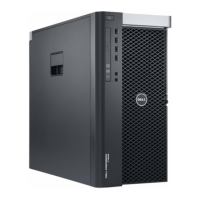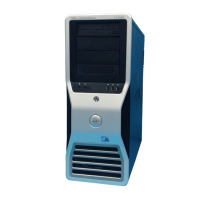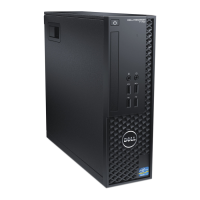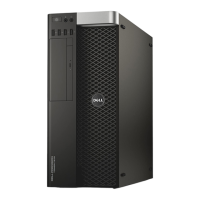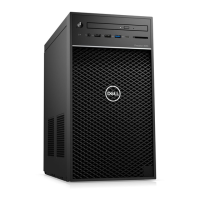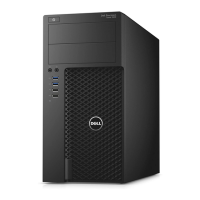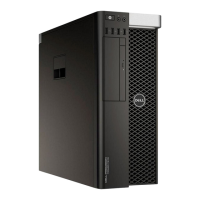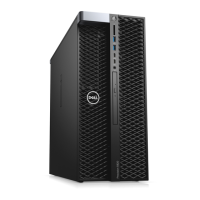Do you have a question about the Dell Precision T7610 and is the answer not in the manual?
Safety precautions and preparation steps before performing internal computer maintenance.
Procedures for properly shutting down the operating system and computer.
Steps for reconnecting peripherals and powering on the computer after maintenance.
Diagram and identification of key internal components within the computer chassis.
Detailed steps to safely detach the power supply unit from the computer chassis.
Detailed steps to safely attach the power supply unit into the computer chassis.
Instructions on how to remove a hard drive from its bay in the computer.
Instructions on how to install a hard drive into its bay in the computer.
Step-by-step guide to detach the left side panel of the computer chassis.
Step-by-step guide to reattach the left side panel of the computer chassis.
Procedures for safely removing memory modules from the system board slots.
Procedures for safely installing memory modules into the system board slots.
Instructions for carefully removing the CPU from its socket on the system board.
Instructions for carefully installing the CPU into its socket on the system board.
Steps to detach the main system board from the computer chassis.
Steps to reattach the main system board into the computer chassis.
Illustrations and labels for major components located on the system board.
General recommendations for optimal performance when configuring system memory.
Description of the mechanism and operation of the front panel security lock.
Description of the mechanism and operation for securing the PSU to the chassis.
Configuration options for setting the order of devices the computer attempts to boot from.
Overview of various configurable settings available within the system's BIOS/UEFI interface.
Procedure for downloading and installing updated BIOS firmware for the system.
Instructions for setting, assigning, changing, and disabling system and setup passwords.
How to run the built-in hardware diagnostic tool for system testing.
Explanation of system status indicators and their meaning during the POST process.
Guide to interpreting various BIOS error messages and their potential causes.
Technical details regarding the CPU types, cores, and cache configurations.
Details on the number of memory slots, supported capacities, and RAM types.
Specifications for PCI, SAS, SATA, and USB ports and their capabilities.
Information on power supply wattage ratings and maximum heat dissipation.
Details on operating temperature, humidity, vibration, and altitude limits.
Safety precautions and preparation steps before performing internal computer maintenance.
Procedures for properly shutting down the operating system and computer.
Steps for reconnecting peripherals and powering on the computer after maintenance.
Diagram and identification of key internal components within the computer chassis.
Detailed steps to safely detach the power supply unit from the computer chassis.
Detailed steps to safely attach the power supply unit into the computer chassis.
Instructions on how to remove a hard drive from its bay in the computer.
Instructions on how to install a hard drive into its bay in the computer.
Step-by-step guide to detach the left side panel of the computer chassis.
Step-by-step guide to reattach the left side panel of the computer chassis.
Procedures for safely removing memory modules from the system board slots.
Procedures for safely installing memory modules into the system board slots.
Instructions for carefully removing the CPU from its socket on the system board.
Instructions for carefully installing the CPU into its socket on the system board.
Steps to detach the main system board from the computer chassis.
Steps to reattach the main system board into the computer chassis.
Illustrations and labels for major components located on the system board.
General recommendations for optimal performance when configuring system memory.
Description of the mechanism and operation of the front panel security lock.
Description of the mechanism and operation for securing the PSU to the chassis.
Configuration options for setting the order of devices the computer attempts to boot from.
Overview of various configurable settings available within the system's BIOS/UEFI interface.
Procedure for downloading and installing updated BIOS firmware for the system.
Instructions for setting, assigning, changing, and disabling system and setup passwords.
How to run the built-in hardware diagnostic tool for system testing.
Explanation of system status indicators and their meaning during the POST process.
Guide to interpreting various BIOS error messages and their potential causes.
Technical details regarding the CPU types, cores, and cache configurations.
Details on the number of memory slots, supported capacities, and RAM types.
Specifications for PCI, SAS, SATA, and USB ports and their capabilities.
Information on power supply wattage ratings and maximum heat dissipation.
Details on operating temperature, humidity, vibration, and altitude limits.
| Tcase | 70 °C |
|---|---|
| Bus type | QPI |
| Stepping | M1 |
| FSB Parity | No |
| Processor cache | 10 MB |
| Processor cores | 4 |
| System bus rate | 6.4 GT/s |
| Processor series | Intel Xeon E5-2600 |
| Processor socket | LGA 2011 (Socket R) |
| Processor codename | Sandy Bridge EP |
| Number of QPI links | 2 |
| Processor frequency | 2.4 GHz |
| Processor cache type | Smart Cache |
| Processor lithography | 32 nm |
| Processor manufacturer | Intel |
| Processor front side bus | - MHz |
| PCI Express slots version | 3.0 |
| Processor operating modes | 64-bit |
| ECC supported by processor | Yes |
| Thermal Design Power (TDP) | 80 W |
| Number of processors installed | 1 |
| CPU multiplier (bus/core ratio) | 24 |
| Maximum number of PCI Express lanes | 40 |
| Memory types supported by processor | DDR3-SDRAM |
| Memory clock speeds supported by processor | 800, 1066 MHz |
| Memory bandwidth supported by processor (max) | 34.1 GB/s |
| Maximum internal memory supported by processor | 750 GB |
| Memory slots | 16x DIMM |
| Internal memory | 16 GB |
| Memory channels | Quad-channel |
| Memory clock speed | 1066 MHz |
| Maximum internal memory | 256 GB |
| Storage media | HDD |
| Card reader integrated | - |
| Total storage capacity | 1000 GB |
| Discrete graphics card model | NVIDIA® Quadro® K4000 |
| On-board graphics card model | Not available |
| Operating system installed | Windows 7 Professional |
| Cabling technology | 10/100/1000Base-T(X) |
| Ethernet LAN data rates | 10, 100, 1000 Mbit/s |
| USB 2.0 ports quantity | 6 |
| USB 3.2 Gen 2 (3.1 Gen 2) Type-A ports quantity | 0 |
| PCI Express x16 (Gen 3.x) slots | 3 |
| Chassis type | Tower |
| Product color | Black |
| Placement supported | Vertical |
| Audio system | HD |
| Product type | Workstation |
| Motherboard chipset | Intel® C602 |
| Password protection type | BIOS |
| Sustainability certificates | ENERGY STAR |
| Certification | CECP, GS |
| Scalability | 2S |
| Processor ARK ID | 64588 |
| Processor package size | 52.5 x 45.0 mm |
| Supported instruction sets | AVX |
| Intel Identity Protection Technology version | 0.00 |
| Depth | 545 mm |
|---|---|
| Width | 216 mm |
| Height | 438 mm |
| Weight | 16900 g |
